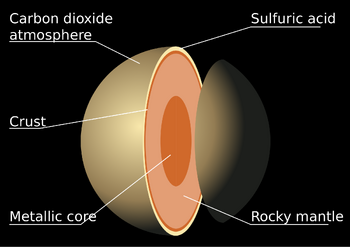Surface and internal structure[]
In terms of volume and mass, Venus closely resembles Earth. The conditions on its surface are drastically different, however. It might be a bit histrionic to describe it as "hellish", but in fact this term provides an excellent description of what happens below its thick cloud layer. A pressure of over 90 atmospheres combined with average temperatures above 740 K, sulphuric acid rain and fierce volcanic eruptions create an environment that from the human perspective seems like the antithesis of a habitable planet.
Not much data is available on the interior structure of Venus. Given its similarity in mass and density to Earth (Venus is about 5% less dense[1] and has 81.5% of Earth's mass) it is conjectured that the venusian interior is tripartite and consists of an at least partially liquid core, mantle and crust.[2]

Diagram of the Venusian interior
Venus lacks recurring tectonic activity. One reason for this could be the absence of liquid water, which would be required to lubricate the crust and reduce its viscosity[3]. This tectonic stasis prevents the planet's core from cooling down, as heat can't be dissipated in resurfacing events. Hence the only valve leading heat from the inside of the to the outside is volcanic activity. There are 167 volcanoes on Venus that exceed a diameter of 100 km and there is enough evidence to infer that they are active. The planet has been mapped in the infrared spectrum and regions whose temperatures were in the range of 800 - 1100 K are likely large streams of freshly released lava. Another noticeable feature of Venus is the moderate amount of impact craters scattered across the surface. This is again caused by the lack of tectonic activity, since a crust that doesn't morph regularly doesn't lose the scars of meteoric bombardment as quickly as it would otherwise. It is estimated that the crust has an age of about 600 millions of years. It has been deduced from this that Venus' surface could indeed be transformed periodically, but only in cataclysmical planet-wide subduction events that occur when the mantle temperatures reach a critical level[4].
Regions with elevations greater than 2 kilometers cover about 10% of the Venusian surface. Radar signals reflected by these regions with unusual efficiency reveal that the surface is radically different on these highlands. While minerals in the lower provinces of Venus are unstable, the lower pressures and temperatures found at higher elevations combined with dielectric properties of the rock formations might provide suitable conditions for a distinct and stable mineralogy. The most prominent of these highlands are the Aphrodite Terra, Ishtar Terra, and Lada Terra, as well as the regions Beta Regio, Phoebe Regio and Themis Regio.[5]

Venus map with labels
Atmosphere[]
The Venusian atmosphere is composed mainly of carbon dioxide and a small percentage of nitrogen. It is so dense that even the 3.5% of nitrogen contained in it exceed the amount of nitrogen found in Earth's atmosphere by four times, even though it accounts for 78% of the Terrestrial atmosphere.[6] The pressure at the surface amounts to 93 bar, roughly the pressure found 900 meters underwater on Earth.[7]
Sulfuric acid is produced in a photochemical reaction that entails carbon dioxide, sulfur dioxide and water. When ultraviolet photons hit carbon dioxide molecules they dissociate them into carbon monoxide and atomic oxygen. The atomic oxygen bonds with sulfur dioxide creating sulfur trioxide, which in turn bonds with water vapour and forms sulfuric acid. The sulfuric acid generated by this reaction forms droplets that are the main component of an opaque cloud layer which blocks 75% of the incoming sunlight. Hence direct observation of the surface is impossible and the amount of solar energy received by the surface is severely limited. The clouds, floating at a height of 50 kilometers, combined with the vast amounts of carbon dioxide supporting them are so effective at trapping solar energy in form of heat that they are responsible for the runaway greenhouse effect which transformed the surface into a furnace. Under the high pressures exerted by the atmosphere the carbon dioxide in the lower atmopshere assumes the properties of a supercritical fluid that transfers heat very efficiently. Due to this high thermal conductivity temperatures near the surface are constant not only between day and night sides but also between the equator and the poles.
The atmosphere of Venus consists of three parts:
- The troposphere, which contains 99% of the atmopsheric mass, begins at the surface and extends to an altitude of 65 kilometers. At a height of about 49.5 kilometers the pressure and the temperature of the venusian air are quite similar to those measured on Earth's surface. While wind speeds in proximity of the surface are not particularly high, near the top of the troposphere they increase dramatically, reaching 85 m/s. The strong cloud-top winds cause a phenomenon known as the super-rotation of the atmosphere. A significant portion of the planet's atmosphere rotates up to sixty times faster than the planet itself, completing an entire cycle in only four days. The atmospheric rotation is also differential, as the winds near the equatorial area blow faster than those in the polar area. The air movements on Venus are caused almost exclusively by convection: air heated by solar lighting rises in the equatorial region and flows to the poles, causing a planet-wide overturning of the troposphere. Large S-shaped vortices with two "eyes" can be observed above the polar regions; they are usually referred to as "polar dipoles".
- to be continued
Habitability[]

The transformation of Venus
Sources[]
- ↑ http://adsabs.harvard.edu/abs/1982LPSC...12.1507G
- ↑ https://en.wikipedia.org/wiki/Venus#Internal_structure
- ↑ http://www.universetoday.com/14069/venus/
- ↑ https://en.wikipedia.org/wiki/Geology_of_Venus#Global_resurfacing_event
- ↑ https://en.wikipedia.org/wiki/Geology_of_Venus#highlands
- ↑ http://www.space.com/18527-venus-atmosphere.html
- ↑ https://en.wikipedia.org/wiki/Atmosphere_of_Venus

















